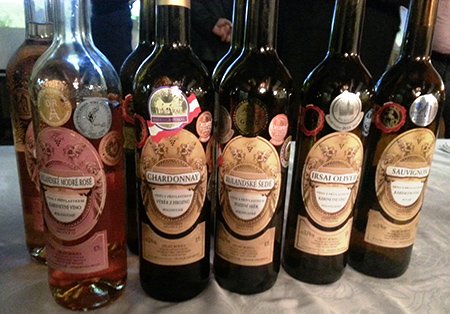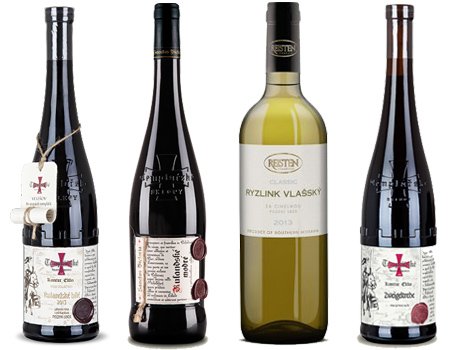|
|||||||||||||
|
|||||||||||||
| Decoding Wine Labels 101a | |||||||||||||
| By Ravi Joshi | |||||||||||||
| Vin, vino or wein – these words strike a common chord since all of them mean "wine" as we know the word in English, and have an uncanny phonetic similarity. Similar meaning words across languages have some common aspects, whether it is the syllables or the phonetics. And these can be related-to sub consciously. | |||||||||||||
 |
|||||||||||||
Getting familiar with Moravian wines from the Czech Republic |
|||||||||||||
| According to a forecast by IWSR, wine consumption in India is poised to show impressive growth in the run up to the year 2017. Intensive promotion activities have been rolled out in the last 15 years to introduce wine to scotch drinking Indians. And wine producers from around the world are warming up to India like never before. | |||||||||||||
| This brings to our peninsular shores, many interesting wines from diverse regions hitherto unfamiliar to the wine enthusiast. Besides the often highlighted tax structure and complicated logistics, there is another hitch – getting unfamiliar label terminology across to the average wine consumer. | |||||||||||||
| I was a bit surprised (even if pleasantly) to receive an invitation from the Ambassador of the Czech Republic H. E. Mr Miloslav Stašek for a tasting of Moravian wines from the Czech Republic (Czechoslovakia bifurcated into the ‘Czech Republic’ and ‘Slovakia’ in the early nineties). | |||||||||||||
| The guest Sommelier from the Czech Republic, Aleš Pokorný, presented very attractively labeled Czech wines to an audience of wine professionals in New Delhi. At the outset, I found that the wines were enjoyable, specially the Irsai Oliver that was aromatic and off dry with characteristics quite close to the Muscat varietal. | |||||||||||||
 |
|||||||||||||
Moravian wines from the Czech Republic |
|||||||||||||
| But, the wines that evening hit a perception barrier – that of unfamiliar names and I could not get myself to enjoy it as much as I should. So I delved deeper, I found that this problem was surmountable, provided some basics were followed. And presto! Decoding Wine Labels 101a was structured. | |||||||||||||
| The genealogy of grapes | |||||||||||||
| Ever since man started cultivating grapes, and trans-continental voyages became a reality, grape varietals have proliferated to distant lands from their place of origin. Further, graftings have yielded derived varietals, giving rise to new genomes. These varietals have been interpreted differently in the local languages – depending on the country of cultivation, similar varietals will get different names. For example, Pinot Blanc is Weiss Burgunder in Germany/ Austria; whereas in the Czech Republic it is Rulandské Bílé. | |||||||||||||
| At times, varietal names may differ within different regions of the same country too, but that will take us into the next level – 201b. I was able to engage Aleš in both an extensive (over time) and intensive (in content) exchange, and I chose the Czech varietals as a case study. | |||||||||||||
| The details, however, lie in deliberation and this brings us to the subject of difficult- to-comprehend wine names, if only so, initially. | |||||||||||||
| Drawing these parallels, we can easily get acquainted with different sounding but essentially the same varietals. | |||||||||||||
| Step One: Establish phonetic similarity | |||||||||||||
| Does Ryzlink ring a bell? Does Sylvánské sounds familiar? Indeed, these are Riesling and Sylvaner respectively, as we commonly know them. Identify phonetic indicators in unfamiliar wine names and you are already half way there. Some examples: | |||||||||||||
| Tramin = Gewurztraminer
Vlašský = Welsch Rýnský = Rhine Veltlínské = Veltliner Zweigeltrebe = Zweigelt Frankovka = Blaufrankisch |
|||||||||||||
| Step Two: Draw parallels | |||||||||||||
| This exercise needs more effort, as the unfamiliar terms will have to be mapped to their common versions by querying the source (in my case Aleš) or Google. Some examples are: | |||||||||||||
| Rulandské = Pinot
Bílé = Blanc Modré = Noir Modrý = Blue Šedé = Gris Pozdní Sber = Late Harvest Jakostni = Quality Víno S Prívlastkem = Highest classification in Czech wines |
|||||||||||||
| Step 3: Get it all together | |||||||||||||
| The task is to leverage familiar words within a complete name and draw conclusions. The other terms in the label would invariably relate to the specific region from where the wine originates or quality related terminology. | |||||||||||||
 |
|||||||||||||
Moravian wines from the Czech Republic |
|||||||||||||
| Some examples are: | |||||||||||||
| 1. Rulandské Modré Rosé = Pinot Noir Rosé
Víno S Prívlastkem = Quality wine Kabinetní Víno = Quality sub-classification |
|||||||||||||
| Inference: A Pinot Noir Rosé wine with the quality sub classification ‘Kabinett’ | |||||||||||||
| 2. Frankovka Rosé = Blaufrankisch Rosé
Víno S Prívlastkem = Quality wine Pozdní Sber = Late Harvest |
|||||||||||||
| Inference : A Blaufrankisch Rosé wine made from late harvested grapes | |||||||||||||
| 3. Modrý Portugal = Blauer Portugieser
Víno S Prívlastkem = Quality wine Výber Z Hroznu = Quality sub classification (selected grapes) |
|||||||||||||
| Inference: A Blauer Portugieser wine made from special selection of grapes. | |||||||||||||
| There may however be exceptions, where the above logic will not apply because the particular grape varietal is native solely to a particular country. In such cases, there is no option but to remember the varietal and take down the tasting notes for posterity. | |||||||||||||
| This model that I have detailed, can be applied to understand wines from any other country having local names for international grape varietals. So next time you are confronted by an alien looking wine label, just pause to look deliberately and you may well find your new love in wines. | |||||||||||||
|
|||||||||||||
|
|||||||||||||











